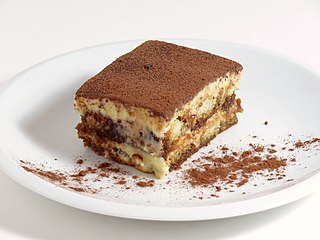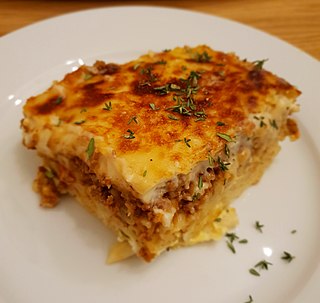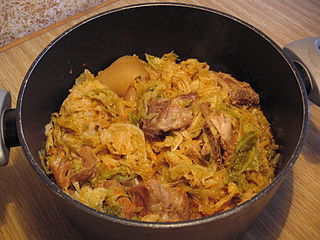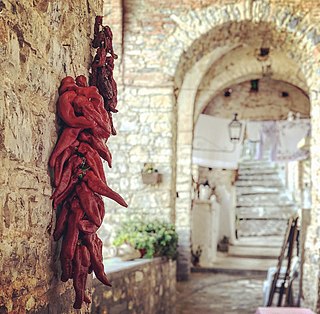
Tiramisu is an Italian dessert made of ladyfinger pastries (savoiardi) dipped in coffee, layered with a whipped mixture of eggs, sugar and mascarpone and flavoured with cocoa. The recipe has been adapted into many varieties of cakes and other desserts. Its origin is disputed between the Italian regions of Veneto and Friuli-Venezia Giulia. The name comes from the Italian tirami su.

Toad in the hole is a traditional English dish consisting of sausages in Yorkshire pudding batter, usually served with onion gravy and vegetables. Historically, the dish has also been prepared using other meats, such as rump steak and lamb's kidney. In the 21st century, vegetarian and vegan versions have appeared.

Risotto is an Italian rice dish cooked with broth until it reaches a creamy consistency. The broth can be derived from meat, fish, or vegetables. Many types of risotto contain butter, onion, white wine, and Parmesan cheese. It is one of the most common ways of cooking rice in Italy. Saffron was originally used for flavour and its signature yellow colour.
Balsamic vinegar is a dark, concentrated, intensely flavoured vinegar originating in Modena, Italy, made wholly or partially from grape must: freshly crushed grape juice with all the skins, seeds and stems.

Pastitsio is a Greek baked pasta dish with ground meat and béchamel sauce, with variations of the dish found in other countries of the Mediterranean Sea.

Pellegrino Artusi was an Italian businessman and writer, best known as the author of the 1891 cookbook La scienza in cucina e l'arte di mangiar bene.

Bistecca alla fiorentina is an Italian steak dish made of young steer (vitellone) or heifer (scottona) that is one of the most famous dishes in Tuscan cuisine. It is loin steak on the bone cooked on a grill until rare (50 °C).

Fruit syrups or fruit molasses are concentrated fruit juices used as sweeteners.

Scaloppine is a type of Italian dish that comes in many forms. It consists of thinly sliced meat, most often beef, veal, or chicken, that is dredged in wheat flour and sautéed in one of a variety of reduction sauces.
Sugoli is a dessert prepared with the must of red grapes, flour and sugar, cooked slowly and then left to cool. The sugoli can be served cool, like a pudding, or preserved in a jar like jam. It is a typical dessert in northern Italy.

Vincotto is a dark, sweet, thick paste produced in rural areas of Italy. It is made by the slow cooking and reduction over many hours of non-fermented grape must until it has been reduced to about one-fifth of its original volume and the sugars present have caramelized. It can be made from a number of varieties of local red wine grapes, including Primitivo, Negroamaro and Malvasia Nera, and before the grapes are picked they are allowed to wither naturally on the vine for about thirty days. In Roman times it was known as sapa in Latin and epsima in Greek, the same names that are often used for it in Italy and Cyprus, respectively, today.

Vino cotto is a type of wine from the Italian regions of Marche and Abruzzo, made primarily in the hills of the province of Ascoli Piceno and the province of Macerata. It is a strong ruby-colored wine, usually semi-sweet, and traditionally drunk in small glasses with puddings and cheese.

The cuisine of Sardinia is the traditional cuisine of the island of Sardinia, and the expression of its culinary art. It is characterised by its own variety, and by the fact of having been enriched through a number of interactions with the other Mediterranean cultures while retaining its own identity. Sardinia's food culture is strictly divided into food from the land and food from the sea, reflecting the island's historical vicissitudes and especially its geographic landscapes, spacing from the coastline to the ragged mountains of the interior. The Sardinian cuisine is considered part of the Mediterranean diet, a nutritional model that was proclaimed by UNESCO as an intangible cultural heritage.

Bolognese sauce, known in Italian as ragù alla bolognese or ragù bolognese, is a meat-based sauce in Italian cuisine, typical of the city of Bologna. It is customarily used to dress tagliatelle al ragù and to prepare lasagne alla bolognese.

Lombard cuisine is the style of cooking in the Northern Italian region of Lombardy. The historical events of its provinces and of the diversity of its territories resulted in a varied culinary tradition. First courses in Lombard cuisine range from risottos to soups and stuffed pasta, and a large choice of second course meat or fish dishes, due to the many lakes and rivers of Lombardy.

Grape syrup is a condiment made with concentrated grape juice. It is thick and sweet because of its high ratio of sugar to water. Grape syrup is made by boiling grapes, removing their skins, squeezing them through a sieve to extract the juice. Like other fruit syrups, a common use of grape syrup is as a topping to sweet cakes, such as pancakes or waffles.
Emiko Davies is an Australia-born cookbook author, food journalist and food blogger, known for a focus on regional Italian food. She is based in Florence, Italy.

The cuisine of Basilicata, or Lucanian cuisine, is the cuisine of the Basilicata region of Italy. It is mainly based on the use of pork and sheep meat, legumes, cereals and vegetables, with the addition of aromas such as hot peppers, powdered raw peppers and horseradish. The local gastronomy is, for historical-cultural reasons, typically peasant, based on simple recipes and on the culture of reuse, in particular of meat and bread.

Cappelletti are ring-shaped Italian stuffed pasta so called for the characteristic shape that resembles a hat. Compared to tortellini, they have a different shape, larger size, thicker dough and different filling.
















